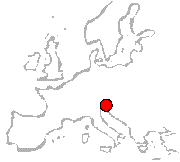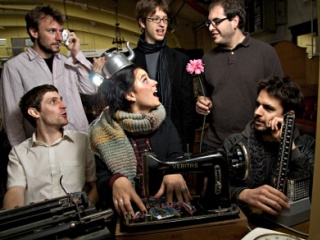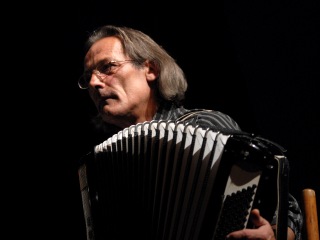FolkWorld #47 03/2012
© Wikipedia, the free encyclopedia
Music of Slovenia
 Republic of Slovenia (Republika Slovenija)
Capital:
Republic of Slovenia (Republika Slovenija)
Capital: Ljubljana
Population: 2,1 mio.
Location:
Central and Southeastern Europe touching the Alps and bordering the Mediterranean. Slovenia borders Italy to the west, Croatia to the south and east, Hungary to the northeast, and Austria to the north, and also has a small portion of coastline along the Adriatic Sea.
In 2012, Slovenia's second largest city Maribor will be the European Capital of Culture
alongside with Guimarães, Portugal.[47]
The music of Slovenia is closely related to Austrian and Northern Italian music because of its common history and Alpine and littoral culture, and in some southern regions to Croatian (especially Istrian). In the minds of many foreigners, Slovenian folk music means a form of polka that is still popular today, especially among expatriates and their descendants in North America. However, there are many styles of Slovenian folk music beyond polka, and waltz. Lender, štajeriš, mafrine and šaltin are a few of the traditional music styles and dances.
Prehistory
The Divje Babe flute, an artifact found in a cave near Cerkno, Slovenia, is possibly the oldest known musical instrument ever. Its age is estimated at approximately 55,000 years.
The history of modern Slovenian music can be traced back to the 5th century, when Christianity spread in Carantania. Liturgical hymns (kyrie eleison) were introduced, and became the first plainchant to make a connection to the peoples' language.
Folk music
Typical Slovenian folk music is performed on Styrian harmonica (the oldest type of accordion), fiddle, clarinet, zithers, flute, and by brass bands of alpine type. In eastern Slovenia, fiddle and cimbalon bands are called velike goslarije. Rural harmony singing is a deep rooted tradition in Slovenia, and is at least three-part singing (four voices), while in some regions even up to eight-part singing (nine voices).
Slovenian folk songs, thus, usually resounds soft and harmonious, and are very seldom in minor. Folk music revivalists include Volk Volk, Kurja Koža, Marko Banda, Katice, Bogdana Herman, Ljoba Jenče, Vruja, Trinajsto praše, Šavrinske pupe en ragacone, Musicante Istriani, and Tolovaj Mataj.
Slavko Avsenik is one of the most influential polka and waltz musicians in Slovenia and the world. Oberkrainer music, which the Avsenik Ensemble popularized, is always a strong candidate for country (folk) music awards in Slovenia and Austria. Slavko and his brother, Vilko, are usually credited as the pioneers of Slovenian folk music, having solidified its style in the 1950s.
Traditional Slovenian music include various kinds of musical instruments such as:
From Wikipedia, the free encyclopedia
[en.wikipedia.org/wiki/Music_of_Slovenia].
Wikipedia® is a registered trademark of the Wikimedia Foundation, Inc., a non-profit organization.
Text is available under the Creative Commons Attribution-ShareAlike License.
Date: February 2012.
Photo Credits:
(1) Europe (by FolkWorld);
(2) Slovenian Colours (unknown);
(3) Maja Osojnik
(by David Murobi, taken from website);
(4) Bratko Bibic (by Alpentöne 2007).
FolkWorld - Home of European Music
 Layout & Idea of FolkWorld © The Mollis - Editors of FolkWorld
Layout & Idea of FolkWorld © The Mollis - Editors of FolkWorld




